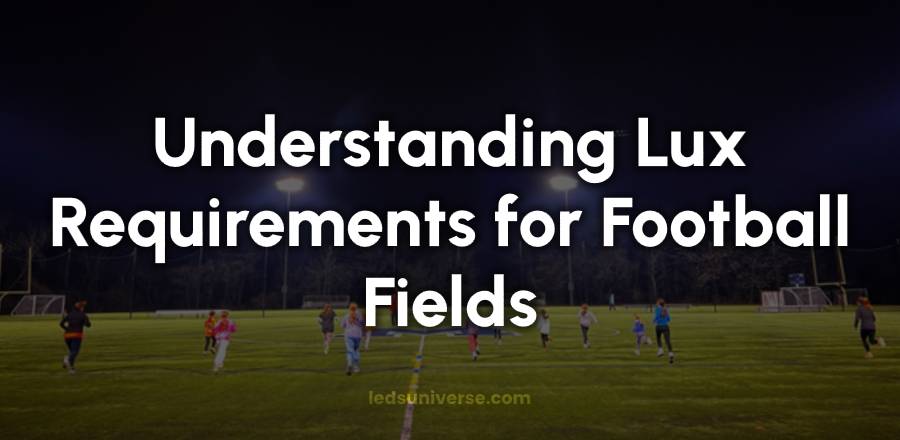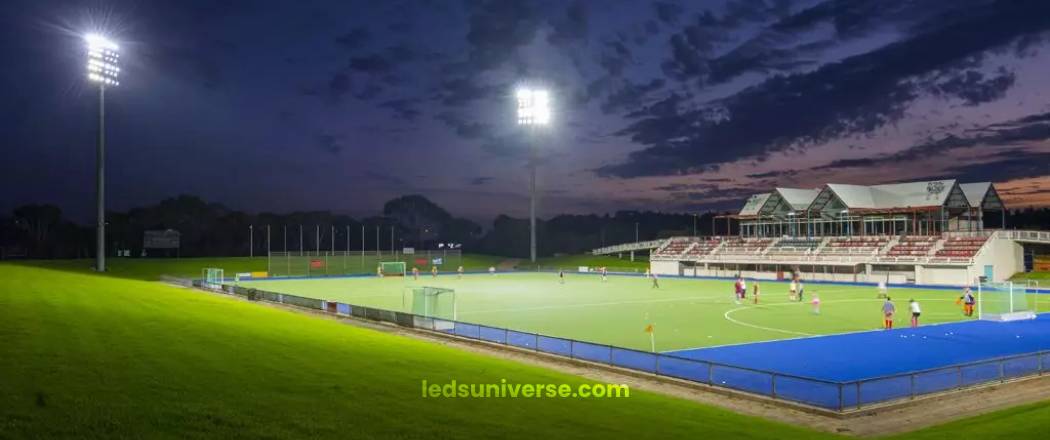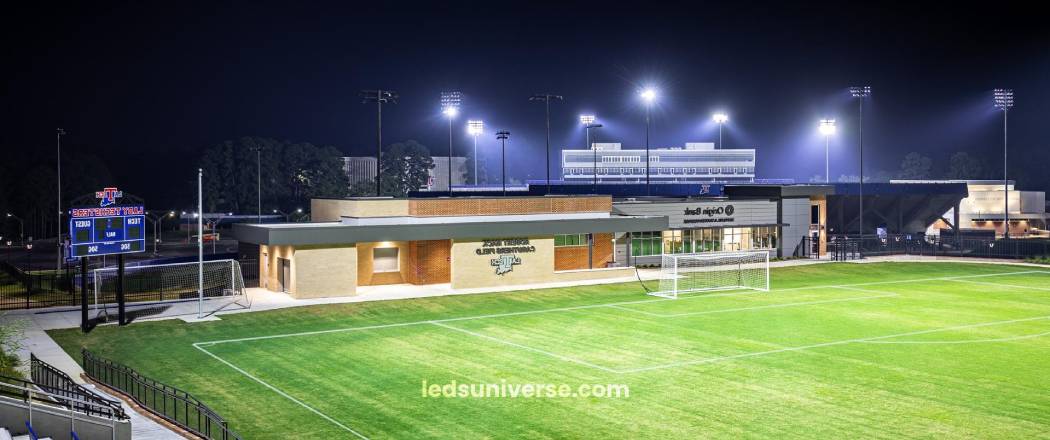
As the sun sets and the stadium lights flicker to life, a vibrant atmosphere envelops the football field, transforming it into a stage where athletes shine and fans roar with excitement. With the rise of advanced lighting technologies, including energy-efficient LEDs, the standards and regulations governing football field illumination are evolving, paving the way for safer, more enjoyable experiences both on the pitch and in the stands.
Football field lighting standards and regulations have evolved significantly over the years, particularly as LED technology has emerged as the preferred solution for illuminating stadiums and arenas. With the increasing popularity of evening matches, proper lighting has become essential for player performance and spectator enjoyment.
Reach out for free lighting consultation
Table of Contents
ToggleIllumination plays a crucial role in the football experience, directly impacting the game and the overall atmosphere at venues. Proper lighting enhances player visibility, boosts performance, and creates a vibrant environment for spectators. As the demand for night games increases, understanding the standards and regulations surrounding football field lighting is vital for all stakeholders involved.
The safety of players on the field is a priority. Adequate lighting allows athletes to see the ball and their teammates clearly, minimizing the risk of accidents or injuries. With well-lit fields, players can assess their surroundings, make better decisions, and perform to the best of their abilities. An effectively illuminated pitch reduces shadows and glare, contributing to a safer playing environment.
Lighting is also integral to the spectator experience. A well-lit field allows fans to see the action clearly, enhancing their enjoyment of the game. Proper illumination can make matches more engaging, as viewers can follow the play without distractions. Additionally, well-designed lighting supports video displays and replays, further immersing spectators in the event.

The standards governing football field lighting are shaped by organizations such as FIFA and UEFA, which have developed guidelines to ensure safety and performance across different levels of play. These standards encompass various factors, including illuminance levels, uniformity, and glare control.
| Class | Purpose | Illuminance (Lux) | Uniformity Ratio | Television Compatibility |
|---|---|---|---|---|
| Class I | Training and recreational use | ~200 | 0.5 | Some facilities may support it |
| Class II | Semi-professional leagues | ~500 | 0.6 | Generally not equipped for TV |
| Class III | National competitions | ~750 | 0.7 | Generally not equipped for TV |
| Professional | Televised events | 1000 – 1500 | U1: 0.6, U2: ~0.8 | Must comply with standards |
Illuminance, measured in lux, refers to the amount of light that falls on the field. Different levels of play require varying illuminance standards. Recreational fields typically have lower lux requirements than professional venues. The illuminance levels recommended for various categories of football play are as follows:
Class I is designed for training and recreational use, with approximately 200 lux of horizontal illumination and a uniformity ratio of 0.5. This standard generally applies to high school sports lighting and local matches.
Class II is used in semi-professional leagues and clubs, requiring about 500 lux of horizontal illumination and a uniformity ratio of 0.6. This standard caters to facilities that host more competitive play.
Class III stadiums are intended for national competitions, necessitating around 750 lux of horizontal illumination and a uniformity ratio of 0.7. Although Class II and III stadiums are not equipped for television broadcasting, some Class I facilities may be designed to support such capabilities, particularly those with average lux levels starting at 1000 lux.
Highly professional stadiums, which host televised events, have specific requirements. The illuminance levels for these venues range from 1000 lux to 1500 lux, with uniformity ratios of U1 at 0.6 and U2 at around 0.8. Facilities must be equipped with high-quality LED sports lights to comply with the latest FIFA and UEFA standards.
Uniformity in lighting distribution is essential for ensuring visibility across the entire field. A uniform lighting design minimizes bright spots and shadows that could disrupt gameplay. The uniformity ratio compares the average illuminance on the field to the minimum illuminance in any area.
For football fields, a uniformity ratio of 0.6 to 0.8 is typically recommended. This ratio ensures that the lowest illumination level is at least 60% to 80% of the average illumination level. Maintaining this uniformity is important for player safety and the overall quality of the game.
Glare can distract players, officials, and spectators, negatively affecting performance and enjoyment. Effective lighting design must consider glare control, ensuring that light sources do not create uncomfortable brightness levels in the field of play.
Strategies for minimizing glare include proper fixture placement, using shields or reflectors, and selecting fixtures designed to reduce glare. Additionally, the color temperature of the lighting impacts perceived brightness, so choosing lights with an appropriate color rendering index can enhance visibility and the overall experience.
For lighting installation, both amateur and professional stadiums must comply with specific methodologies. According to LED lighting installations aligned with FIFA and UEFA standards, the number of masts, their height, and the expected ground lux will vary based on the field size.
Four corners lighting refers to masts positioned in each corner of the field. Light beams converge toward the center of the pitch. In professional stadium lighting, the installation height of these masts should be as high as possible to allow light to travel efficiently to the center while maintaining good glare control and uniformity.
If the poles are too low, the light may not reach the central area effectively, resulting in uneven brightness distribution. To achieve uniform lighting, an installation height of around 30 meters is required in a Class I stadium, ensuring quality projection.
As the name suggests, this setup features four poles centrally located along the two sides of the field. Light beams emanate from the center, distributing illumination across the entire area. While designing a lighting solution, it is essential to consider the four corners. The height of these poles should be sufficient but does not necessarily need to match the height of the four corners lighting poles.
In some cases, customers may opt for six or eight poles for their lighting installation. With more poles, the height does not need to be as considerable, as increased pole quantity enhances lighting uniformity and distribution. Typically, a height of 8 to 12 meters is suitable for training courts, colleges, or high school sports lighting installations.
The poles should be spaced evenly, as more poles facilitate better light distribution. Although installing more poles may increase the budget, lower masts can often be more economical than taller ones. Therefore, multiple factors must be carefully evaluated to create a project that adheres to FIFA and UEFA football field lighting standards and regulations.

While standards provide guidelines for lighting design, regulations dictate the requirements that facilities must adhere to for safety and compliance. These regulations can vary by region but generally focus on several key areas.
Different regions may have specific laws governing outdoor lighting, particularly in urban or residential areas. Local regulations may address permissible light levels, operational hours, and restrictions on light pollution. Facility operators must be aware of these regulations to avoid potential fines and to maintain positive relationships with the community.
Regulatory bodies often outline safety considerations related to lighting. These guidelines may cover installation, maintenance, and testing to ensure that all lighting systems operate effectively. Regular inspections may be mandated to verify compliance with safety standards, ensuring that any issues are promptly addressed.
In addition to local laws, environmental regulations may also apply to football field lighting. These regulations aim to minimize light pollution and reduce energy consumption. Sustainable practices, such as using energy-efficient lighting systems and incorporating smart technology for lighting control, can help facilities comply with environmental standards while lowering operational costs.
The evolution of football field lighting continues with advancements in technology, leading to improved efficiency, performance, and sustainability.
Light Emitting Diodes (LEDs) have become increasingly popular for sports lighting due to their energy efficiency and longevity. LED systems consume significantly less energy than traditional lighting methods, leading to reduced operational costs. Additionally, LEDs provide high-quality illumination with various color temperatures, enhancing visibility and spectator enjoyment.
The lifespan of LED fixtures reduces the need for frequent replacements, which minimizes maintenance costs and downtime for the facility. Consequently, many football fields are transitioning to LED lighting systems to capitalize on these benefits.
Smart lighting technology is transforming how facilities manage their lighting systems. These systems can be programmed to adjust illumination levels based on specific requirements, such as time of day, weather conditions, or the type of event.
During practice sessions, lights can be dimmed to lower levels, conserving energy while still providing adequate visibility. When a game begins, the system can automatically increase brightness to meet professional standards. Such flexibility enhances operational efficiency and improves the overall experience for players and spectators.
With advancements in LED technology and smart lighting solutions, facilities can achieve efficient, high-quality lighting that meets the demands of modern football. As the sport continues to grow in popularity and the need for night games increases, proper lighting will remain a fundamental aspect of field design and management. By prioritizing compliance with lighting standards and engaging with community concerns, stadium operators can create safe, enjoyable environments for players and fans alike.